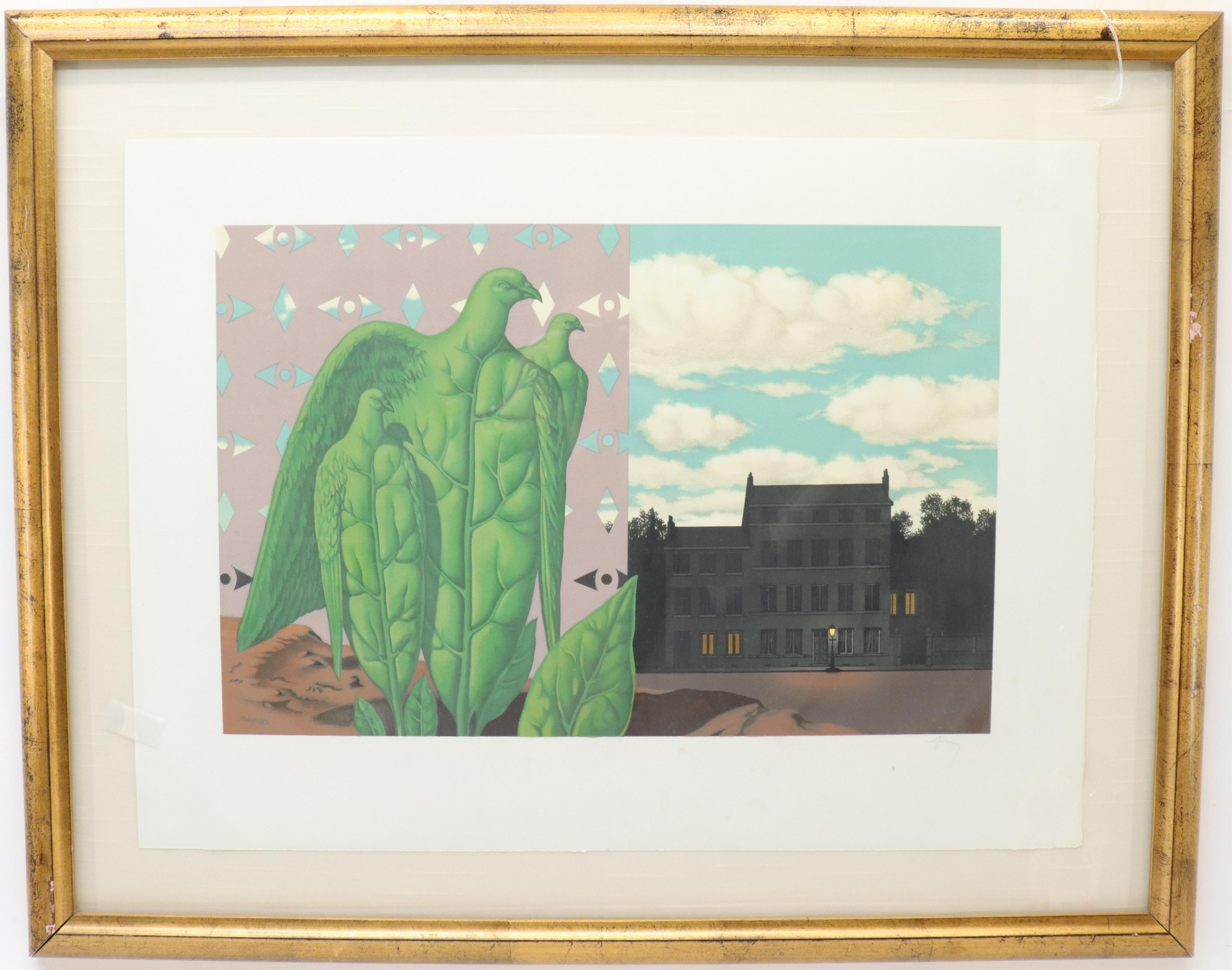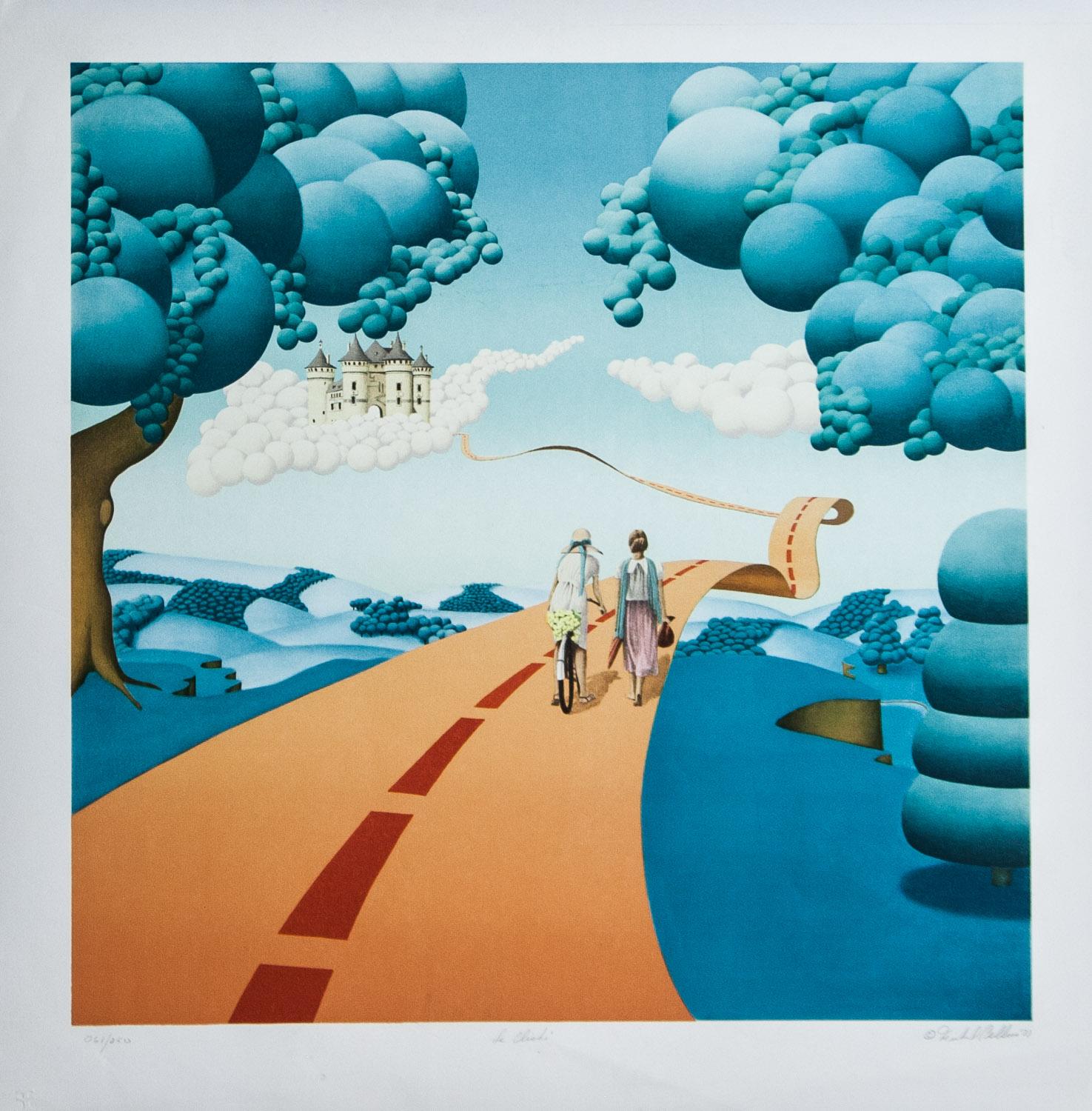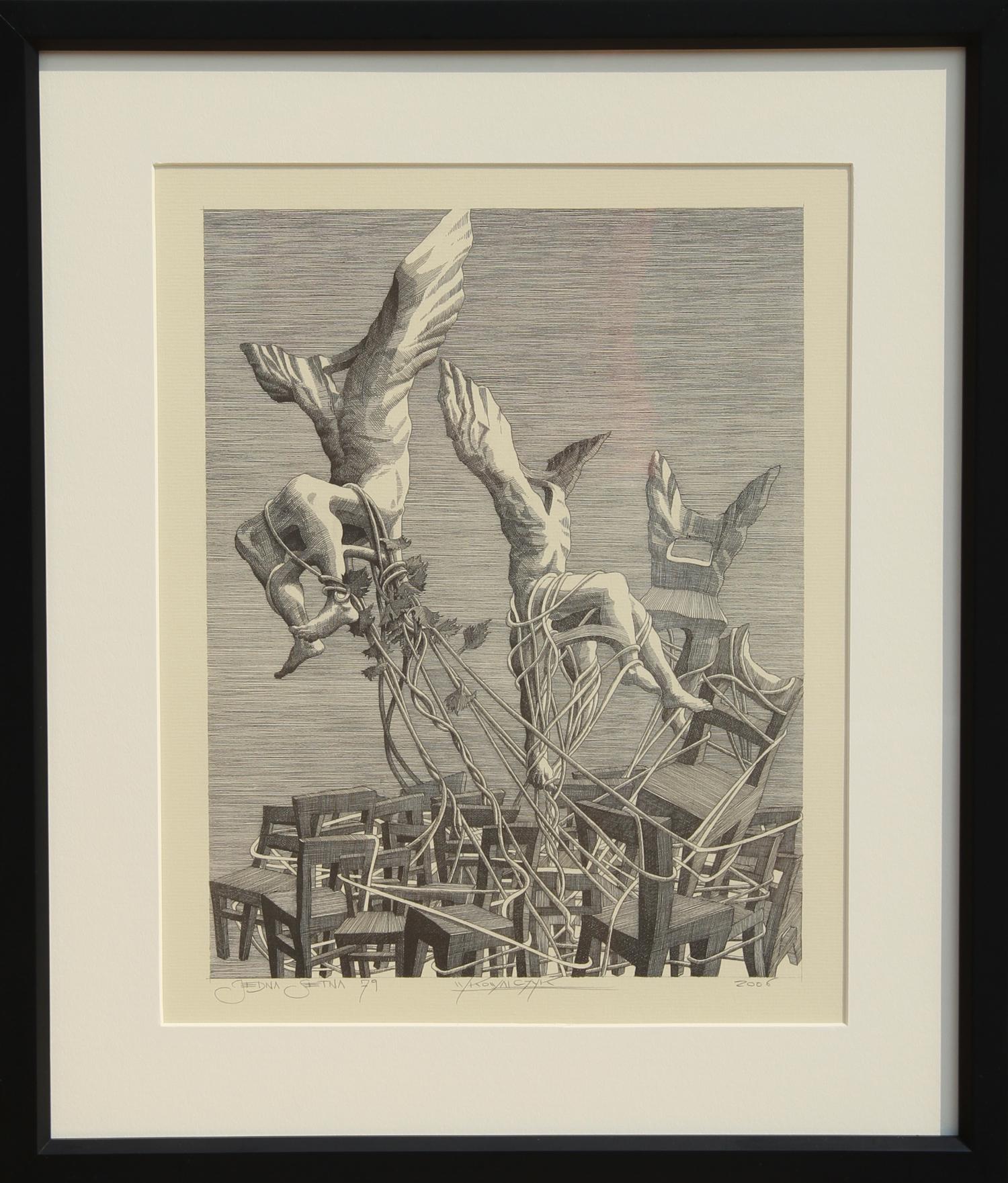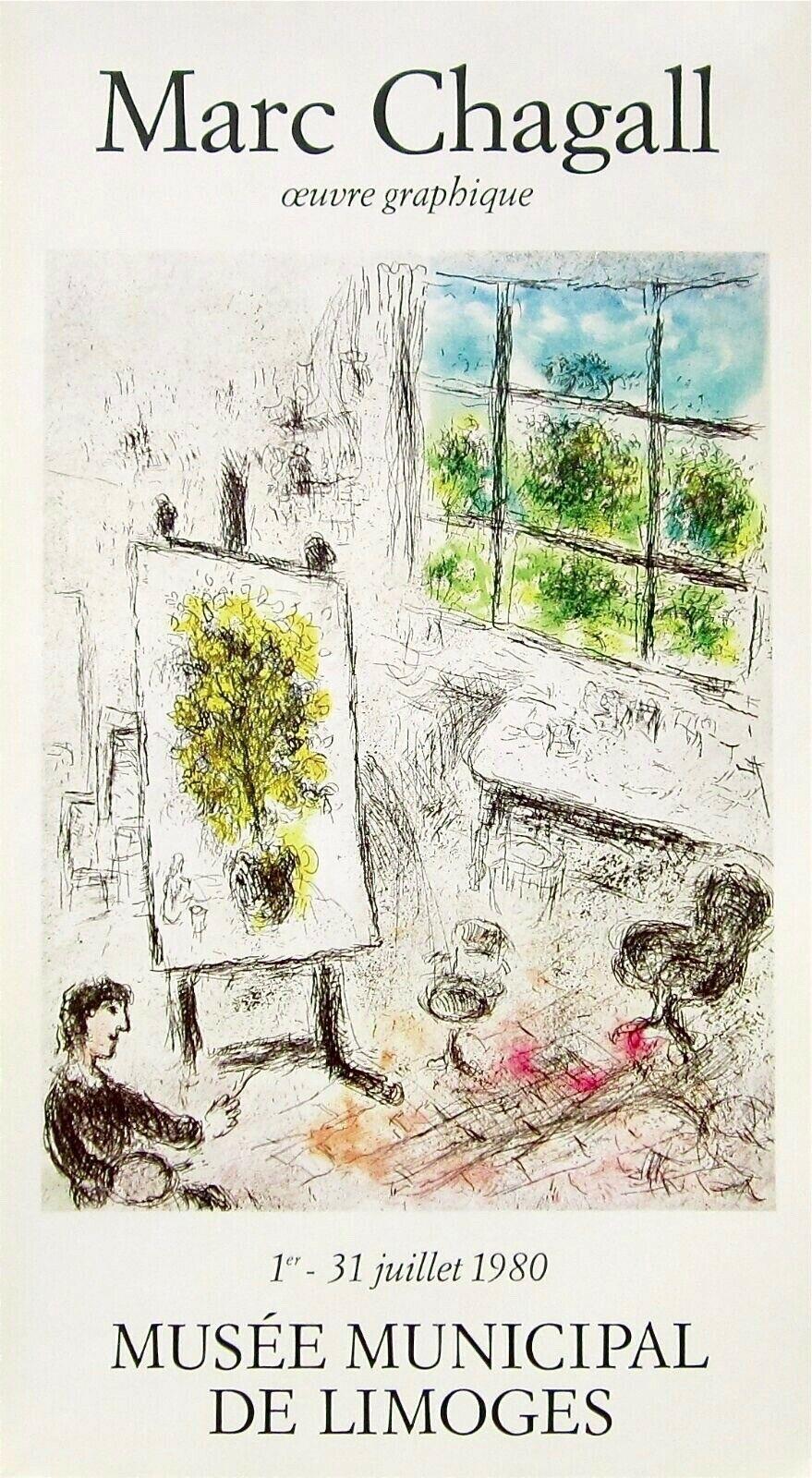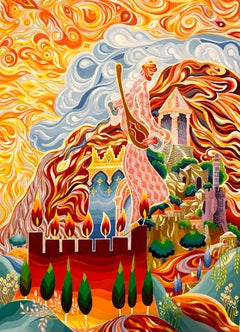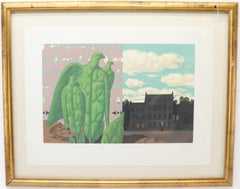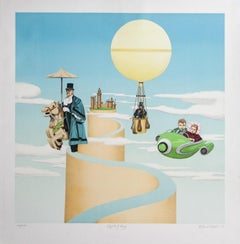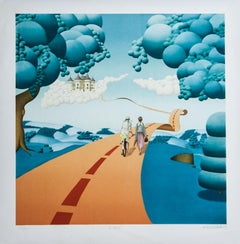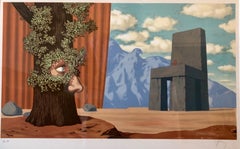
Surrealist Dream Lithograph Belgian Master Magritte Pencil Signed by Mourlot
View Similar Items
Want more images or videos?
Request additional images or videos from the seller
1 of 15
(after) René MagritteSurrealist Dream Lithograph Belgian Master Magritte Pencil Signed by Mourlot1968
1968
About the Item
- Creator:(after) René Magritte (1898 - 1967, Belgian)
- Creation Year:1968
- Dimensions:Height: 24.63 in (62.57 cm)Width: 28.63 in (72.73 cm)
- Medium:
- Movement & Style:
- Period:
- Condition:good. minor wear to frame. ready to hang.
- Gallery Location:Surfside, FL
- Reference Number:1stDibs: LU3825086902
(after) René Magritte
Rene Magritte was born in Lessines, in 1898. Magritte's earliest oil paintings, which date from about 1915, were Impressionistic in style. From 1916 to 1918 he studied at the Academie Royale des Beaux-Arts in Brussels, under Constant Montald, but found the instruction uninspiring. The oil paintings he produced during the years 1918-1924 were influenced by Futurism and by the offshoot of Cubism practiced by Metzinger. Most of his works of this period are female nudes. In 1922 Magritte married Georgette Berger, whom he had met as a child in 1913. From December 1920 until September 1921, Magritte served in the Belgian infantry in the Flemish town of Beverlo near Leopoldsburg. In 1922-1923, he worked as a draughtsman in a wallpaper factory, and was a poster and advertisement designer until 1926, when a contract with Galerie la Centaure in Brussels made it possible for him to paint full-time. In 1926, Magritte produced his first surreal oil painting, The Lost Jockey (Le jockey perdu), and held his first exhibition in Brussels in 1927. Critics heaped abuse on the exhibition. Depressed by the failure, he moved to Paris where he became friends with Andre Breton, and became involved in the surrealist group. During the German occupation of Belgium in World War II he remained in Brussels, which led to a break with Breton. He briefly adopted a colorful, painterly style in 1943-44, an interlude known as his "Renoir Period", as a reaction to his feelings of alienation and abandonment that came with living in German occupied Belgium. In 1946, renouncing the violence and pessimism of his earlier work, he joined several other Belgian artists in signing the manifesto Surrealism in Full Sunlight. During 1947-48-Magritte's "Vache Period"-he painted in a provocative and crude Fauve style. During this time, Magritte supported himself through the production of fake painting of Picasso, van Gogh, Manet and Paul Cezanne - a fraudulent repertoire he was later to expand into the printing of forged banknotes during the lean postwar period. This venture was undertaken alongside his brother Paul Magritte and fellow Surrealist and 'surrogate son' Marcel Marien, to whom had fallen the task of selling the forgeries. At the end of 1948, he returned to the style and themes of his prewar surrealistic art. Magritte wished to cultivate an approach that avoided the stylistic distractions of most modern painting. While French Surrealists experimented with new techniques, Magritte settled on a deadpan, illustrative technique that clearly articulated the content of his pictures. Repetition was an important strategy for Magritte, informing not only his handling of motifs within individual pictures, but also encouraging him to produce multiple copies of some of his greatest works. His interest in the idea may have come in part from Freudian psychoanalysis, for which repetition is a sign of trauma. But his work in commercial art may have also played a role in prompting him to question the conventional modernist belief in the unique, original work of art.
About the Seller
4.9
Platinum Seller
These expertly vetted sellers are 1stDibs' most experienced sellers and are rated highest by our customers.
Established in 1995
1stDibs seller since 2014
1,565 sales on 1stDibs
Typical response time: 1 hour
More From This SellerView All
- Surrealist Dream Lithograph Belgian Master Magritte Pencil Signed by MourlotBy (after) René MagritteLocated in Surfside, FLArtist: Rene Magritte (after), Belgian (1898 - 1967) Title: (from les Enfants Trouvés) Les Claires-Voies d'un Jeune Regard Embaument La Fête d'un Vieil Arbre Year of original paintin...Category
1960s Surrealist Landscape Prints
MaterialsLithograph
- Large Colorful Jerusalem Israeli Judaica Surrealist Lithograph on Heavy PaperBy Baruch NachshonLocated in Surfside, FLTHis is a fabulous, Surrealist lithograph in bright fauvist colors by Hasidic mystic Boruch Nachshon It depicts jerusalem with King David and a menorah in a Jerusalem Landscape. Bar...Category
20th Century Surrealist Figurative Prints
MaterialsLithograph
- Surrealist Dream Lithograph Belgian Master Magritte Pencil Signed by MourlotBy René MagritteLocated in Surfside, FLArtist: Rene Magritte (after), Belgian (1898 - 1967) Title: (from les Enfants Trouvés) Les Claires-Voies d'un Jeune Regard Embaument La Fête d'un V...Category
1960s Surrealist Landscape Prints
MaterialsLithograph
- Simka Simkhovitch WPA Artist Lithograph Island Beach 1933 American ModernistBy Simka SimkhovitchLocated in Surfside, FLSimka Simkhovitch (Russian/American 1893 - 1949) signed lithograph. Pencil signed and dated "S. Simkhovitch 1933" lower center. Title "Island Beach," in pencil lower left of sheet. Numbered "44/50" in pencil lower right. (it is either Island Beach Wisconsin or New Jersey) Simka Simkhovitch (Симха Файбусович Симхович) (aka Simka Faibusovich Simkhovich) (Novozybkov, Russia May 21, 1885 O.S./June 2, 1885 N.S.—Greenwich, Connecticut February 25, 1949) was a Ukrainian-Russian Jewish artist and immigrant to the United States. He painted theater scenery in his early career and then had several showings in galleries in New York City. Winning Works Progress Administration (WPA) commissions in the 1930s, he completed murals for the post offices in Jackson, Mississippi and Beaufort, North Carolina. His works are in the permanent collections of the Dallas Museum of Art, the National Museum of American Art and the Whitney Museum of American Art. Born outside Kyiv (Petrograd Ukraine) into a Jewish family who owned a small department store. During a severe case of measles when he was seven, Simcha Simchovitch sketched the views outside his window and decided to become an artist, over his father's objections. Beginning in 1905, he studied at the Grekov Odessa Art School and upon completion of his studies in 1911 received a recommendation to be admitted to the Imperial Academy of Arts. Though he enrolled to begin classes in architecture, painting, and sculpture at the Imperial Academy, he was dropped from the school roster in December because of the quota on the number of Jewish students and drafted into the army. Simchovitch served as a private in the 175th Infantry Regiment Baturyn [ru] until his demobilization in 1912. Re-enrolling in the Imperial Academy, he audited classes. Simka Simkhovitch exhibited paintings and sculptures in 1918 as part of an exhibition of Jewish artists and in 1919 placed 1st in the competition "The Great Russian Revolution" with a painting called "Russian Revolution" which was hung in the State Museum of Revolution. In 1922, Simkha Simkhovitch exhibited at the International Book Fair in Florence (Italian: Fiera Internazionale del Libro di Firenze). In 1924, Simkhovitch came to the United States to make illustrations for Soviet textbooks and decided to immigrate instead. Initially he supported himself by doing commercial art and a few portrait commissions. In 1927, he was hired to paint a screen for a scene in the play "The Command to Love" by Fritz Gottwald and Rudolph Lothar which was playing at the Longacre Theatre on Broadway. Art dealers began clamoring for the screen and Simkhovitch began a career as a screen painter for the theater. Catching the attention of the screenwriter, Ernest Pascal, he worked as an illustrator for Pascal, who then introduced him to gallery owner, Marie Sterner. Simkhovitch's works appeared at the Marie Sterner Gallery beginning with a 1927 exhibit and were repeated the following year. Simkhovitch had an exhibit in 1929 at Sterner's on circus paintings. In 1931, he held a showing of works at the Helen Hackett Gallery, in New York City and later that same year he was one of the featured artists of a special exhibit in San Francisco at the California Palace of the Legion of Honor in Lincoln Park. The exhibit was coordinated by Marie Sterner and included four watercolors, including one titled "Nudes". He is of the generation of Russian Soviet artists such as Isaac Pailes, Serge Charchoune, Marc Chagall, Chana Orloff, Isaac Ilyich Levitan, and Ossip Zadkine. In 1936, Simkhovitch was selected to complete the mural for the WPA Post office project in Jackson, Mississippi. The mural was hung in the post office and courthouse in 1938 depicted a plantation theme. Painted on the wall behind the judge’s bench, “Pursuits of Life in Mississippi”, a depiction of black workers engaged in manual labor amid scenes of white professionals and socialites, was eventually covered over in later years during renovations due to its stereotypical African American imagery. The following year, his painting "Holiday" won praise at an exhibition in Lincoln, Nebraska. In 1940, Simkhovitch's second WPA post office project was completed when four murals, "The Cape Lookout Lighthouse and the Orville W. Mail Boat", "The Wreck of the Crissie Wright", "Sand Ponies" and "Canada Geese" were installed in Beaufort, North Carolina. The works were commissioned in 1938 and did not generate the controversy that the Jackson mural had. The main mural is "The Wreck of the Crissie Wright" and depicts a shipwreck which had occurred in Beaufort in 1866. "The Cape Lookout Lighthouse and the Orville W. Mail Boat" depicted the lighthouse built in 1859 and the mail boat that was running mail during the time which Simkhovitch was there. The boat ran mail for the area until 1957. "Sand Ponies" shows the wild horses common to the North Carolina barrier islands and "Canada Geese" showed the importance of hunting and fishing in the area. All four murals were restored in the 1990s by Elisabeth Speight, daughter of two other WPA muralists, Francis Speight...Category
1930s American Modern Landscape Prints
MaterialsLithograph
- 1936 Lithograph Soldiers in battle World War I small editionBy George GroszLocated in Surfside, FLAccording to the frontis these were produced by Hand Lithography. According to the Museum of Modern Art (MOMA NY) website "Edition:300 announced; only approx. 42 issued (including regular edition of 30, deluxe edition of approx. 10, and 2 artist's proofs)" I believe these are from the deluxe edition as they are on Mould made BFK Rives French paper and the dimensions are larger than stated in the MOMA website. the sheet size here is 40X29 cm. Date 1936. Publisher:Black Sun Press, New York. Printer:George C. Miller & Son, New York. most of them are plate signed. George Grosz (July 26, 1893 – July 6, 1959) was a German artist known especially for his Satire and Caricature drawings of Berlin life in the 1920s. He was a prominent member of the Berlin Dada and New Objectivity group during the Weimar Republic before he emigrated to the United States in 1933. He studied at the Dresden Academy of Fine Arts, where his teachers were Richard Müller, Robert Sterl, and Oskar Schindler. He subsequently studied at the Berlin College of Arts and Crafts under Emil Orlik. Grosz left the Communist Party KPD in 1922 after having spent five months in Russia and meeting Lenin and Trotsky, because of his antagonism to any form of dictatorial authority. Along with Otto Dix, he is widely considered one of the most important artists of the Neue Sachlichkeit. Bitterly anti Nazi, Grosz left Germany shortly before Hitler came to power. In June 1932, he accepted an invitation to teach the summer semester at the Art Students League of New York. In October 1932, Grosz returned to Germany, but on January 12, 1933 he and his family emigrated to America. In 1946 he published his autobiography, A Little Yes and a Big No. In the 1950s he opened a private art school at his home and also worked as Artist in Residence at the Des Moines Art Center. Grosz was elected into the National Academy of Design as an Associate Academician in 1950. In 1954 he was elected to the American Academy of Arts and Letters. Grosz worked in a style influenced by Expressionism and Futurism, as well as by popular illustration, graffiti, and children's drawings.The City (1916–17) was the first of his many paintings of the modern urban scene. Other examples include the apocalyptic Explosion (1917), Metropolis (1917), and The Funeral, a 1918 painting depicting a mad funeral procession. In his drawings, usually in pen and ink which he sometimes developed further with watercolor, Grosz did much to create the image most have of Berlin and the Weimar Republic in the 1920s. Corpulent businessmen, wounded soldiers, prostitutes, sex crimes and orgies were his great subjects His draftsmanship was excellent although the works for which he is best known adopt a deliberately crude form of caricature. His oeuvre includes a few absurdist works, and also includes a number of erotic artworks. ("Ecce Homo" which saw him accused of pornography) My Drawings expressed my despair, hate and disillusionment, I drew drunkards; puking men; men with clenched fists cursing at the moon. ... I drew a man, face filled with fright, washing blood from his hands ... I drew lonely little men fleeing madly through empty streets. I drew a cross-section of tenement house: through one window could be seen a man attacking his wife; through another, two people making love; from a third hung a suicide with body covered by swarming flies. I drew soldiers without noses; war cripples with crustacean-like steel arms; two medical soldiers putting a violent infantryman into a strait-jacket made of a horse blanket ... I drew a skeleton...Category
1930s Landscape Prints
MaterialsLithograph
- Israeli Naive Art Screen Print Lithograph Jerusalem, Sanhedrin Old City Folk ArtBy Gabriel CohenLocated in Surfside, FLBold color lithograph, hand signed in pencil and numbered AP IX/X (artist’s proof 9/10), Jerusalem Print Workshop blind stamp lower right. On French Arches paper. Gabriel Cohen, Self taught, Naive painter was born in Paris in 1933, to parents from Jerusalem with a father who studied the kabbalah. Throughout World War II, the family hid from the Nazis in Paris. Images of Nazi soldiers appear in several of his paintings. In 1949, when Gabriel was 16, the family returned to Israel. They managed to save enough money to move back to the quarter where both parents were born: Ohel Moshe in Nachlaot. Gabriel served in the artillery corps and after the army, went back to live in his parents' house and earned a living polishing diamonds. The head of the polishing plant, who noticed his employee's artistic skill, allowed him to paint during work hours. He once asked Cohen if he could draw a tiger. Cohen drew him a tiger. And he did a lot of sculpting and painting on glass. He also loved to play the guitar, especially flamenco style. Critics say he is one of Israel's greatest naive-style painters. Along with Shalom of Safed, Kopel Gurwin and Natan Heber, He is renowned as one of Israel's greatest living naive-style folk art painters, recipient of the Jerusalem Prize for Art (1987), a permanent entry in encyclopedias of naive painting, who exhibited his work not only in Israel, but also in Paris, Venezuela, Denmark and Germany; the same Gabriel Cohen whose colorful , bold paintings were exhibited at the Jewish Museum in New York in 1987 alongside works by Marc Chagall; the same Gabriel Cohen about whom curator and art scholar Gideon Ofrat says, "There is no questioning his greatness." He has shown in Paris on the Rue de Rosiers in the Marais. His impressions of his journeys, mostly imaginary, yet some real, are expressed in Cohen's paintings. Huge, colorful canvases rich in precise detail and fantasy, in which he paints the Eiffel Tower and the Russian steppes or the vistas of Paris and the Tower of Babel "In my opinion, it's also because the Tower of Babel has some kind of phallic, erotic meaning, but also because of the internationalism, of the mixture and confusion of nations, which is an essential element in Gabi Cohen's work," says Gideon Ofrat. There is no superlative that has not been lavished on Cohen's work by art critics, since he began showing his paintings at age 40, All the art critics seemed to agree at once that Cohen is one of the greatest naive-style painters in Israel. Their counterparts abroad seconded this view. About a year and a half ago, Zadka organized a show for Cohen at the Jerusalem Artists' House. The Tel Aviv Museum bought a painting of Gabi's and so did the Israel Museum, and several artists bought his drawings. He is a great, great painter. There is no painter who is more of a symbolist and illustrative artist than he is. As a painter myself, I admire him." The Yom Kippur War in 1973 sparked an artistic breakthrough for Cohen; it was at that time that he began to sit on the sidewalk after his work as a diamond polisher and paint. Not long afterward, in early 1974, he did a painting he called "Moses on the Mountain." Ruth Debel, of the Debel Gallery in Ein Kerem, passed by and saw it on the street. She asked how much he wanted for it, and for the first time in his life, he realized that his work had financial value. His first show was at the Debel Gallery in 1974. The response was overwhelming. Cohen was immediately declared a genius. His paintings at the gallery were purchased and he continued to create new paintings. That same year, he was invited to take part in a group exhibition of naive artists at the Kunsthaus in Zurich, and a year later, his work was included in a traveling show of naive-style artists from Israel that was exhibited in Denmark and Germany. Soon after that he was invited to be part of group shows in Venezuela and at the Tel Aviv Museum. Cohen had four solo shows at the Debel Gallery. Awards And Prizes 1987 Jerusalem Prize for Painting and Sculpture 1999 Shoshana Ish-Shalom Prize for special contribution to art, Jerusalem He has exhibited alngside all of the Israeli great artists. including Naive Art Group exhibition Gvanim Art Gallery, Jerusalem Rubin, Rachel Roman, Yitzhak Zarembo, Leah Moscovitz, Shalom (of Safed) Steinberg, Michael Danisov, Salva Harbon, Haim Cohen, Gabriel Chanannia, Joseph (Jojo) Local Hero...Category
20th Century Folk Art Landscape Prints
MaterialsScreen, Lithograph
You May Also LikeView All
- Flights of Fancy original lithograph by Michel Pellus 1977By Michel Pellus 1Located in Paonia, COFlights of Fancy is an original signed limited edition (060/250 ) lithograph by Michel Pellus showing a man in a top hat floating in the sky in a hot a...Category
1970s Surrealist Figurative Prints
MaterialsLithograph
- Marc Chagall - La Place de la Concorde - Original LithographBy Marc ChagallLocated in Collonge Bellerive, Geneve, CHMarc Chagall Original Lithograph Title: La Place de la Concorde 1962 Dimensions: 39 x 30 cm Edition: 180 Unsigned as issued. From Regards sur Paris Reference: Catalogue Raisonné, Mo...Category
1960s Surrealist Figurative Prints
MaterialsLithograph
- Le Cliche original lithograph by Michel Pellus 1977By Michel Pellus 1Located in Paonia, COLe Cliche is an original lithograph by Michel Pellus 1977. A delightful fantasy image of two woman side by side, one walking and one on a bicycle. T...Category
1970s Surrealist Landscape Prints
MaterialsLithograph
- Intra-Uterine Paradesic Locomotion (Imagination & Objects), Salvador DaliBy Salvador DalíLocated in Fairfield, CTArtist: Salvador Dali (1904-1989) Title: Intra-Uterine Paradesic Locomotion (Imagination & Objects of the Future Portfolio) Year: 1975 Medium: Lithograph on Rives BFK paper Edition: ...Category
1970s Surrealist Landscape Prints
MaterialsLithograph, Mixed Media
$4,400 Sale Price20% Off - Salvador Dali (after) - New-York: Plaza (poster edition) - LithographBy (after) Salvador DaliLocated in Collonge Bellerive, Geneve, CHLithograph after an original watercolor by Salvador Dali Title: New-York City : Plaza (pre-text/"avant la lettre" poster edition) Printed Signature, da...Category
1960s Surrealist Figurative Prints
MaterialsLithograph
- "Venise en Fleurs" from "Je Reve, " Surrealist Lithograph signed by Andre MassonBy André MassonLocated in Milwaukee, WI"Venise en Fleurs" is an original color lithograph by Andre Masson. This piece is from the "Je Reve" (I Dream) portfolio of 1975. The edition number, written lower left, is H.C. XXV/...Category
1970s Surrealist Figurative Prints
MaterialsLithograph
Recently Viewed
View AllMore Ways To Browse
Belgium Stone Art
Dream Surrealism Dali
John Baldessari Print
Magritte Art Exhibit
Paintings In The Style Of Rene Magritte
Rene Magritte Lithographs
Joan Miro 1965
1965 Salvador Dali Prints
Dali Lithograph Limited Edition
Salvador Dali Lithograph Limited Edition
1968 Salvador Dali Signed Print
Andy Warhol Eyes
Magritte Original Painting
Rene Magritte Original
Miro 1938
Julien Levy
John Baldessari Signed
Rene Magritte Hand Signed

